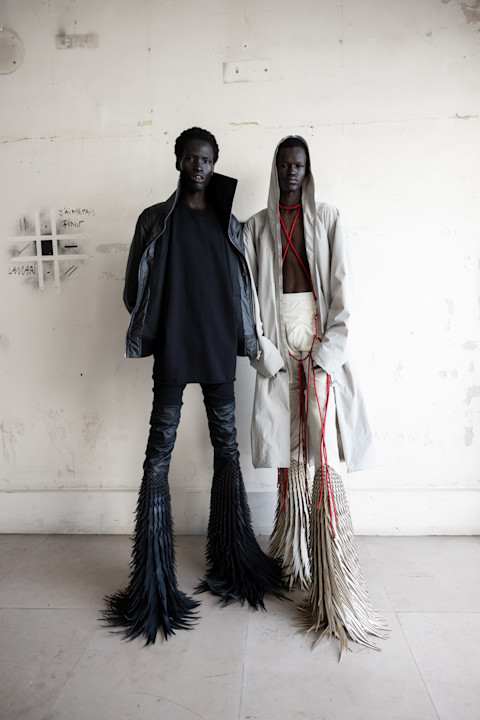Christine Sun Kim Writes in All Caps
On the occasion of her new exhibition at The Whitney, the Berlin-based artist talks to E. Alex Jung about creative obsession and cringe.

Christine Sun Kim is walking me through her upcoming show at The Whitney, , the first major institutional survey of her work. It’s a couple of weeks before the opening and we’ve entered the museum in medias res. Sticky notes dot the wall, and there are decisions to be made in every corner. Her muralist Jake Kent has begun painting “Ghost(ed) Notes,” which will be the first thing visitors encounter when they enter the eighth floor: long four-line staffs that swivel around musical notes that “don’t even realize they got ghosted,” she says, speaking in ASL with one of her long-time interpreters Beth Staehle. The piece considers what exists outside of audibility, and is a cheeky way to introduce her work to a wider public, which often explores the social currency of sound and its exclusionary effects. The show is also a personal homecoming of sorts. Fresh out of art school, Kim worked at The Whitney as an educator giving tours before pursuing her artistic practice in earnest. “Full circle, baby,” she laughs.
The retrospective takes stock of her work at the start of the 2010s moving into the present. Kim, 44, grew up in Orange County, California, before moving to New York for college and grad school, and eventually to Berlin, where she has spent the better part of her artistic career. She came into her aesthetic, as she has said it, when she told an ex-boyfriend that she wanted to work in sound. He thought it was a bad idea, which made her think it was a good idea. Her practice has an obsessive, iterative nature: text and images repeat and regenerate in different guises and scales. She borrows from musical notation to render ASL into a visual language, which doesn’t have an established written system. She has a graphic sensibility shot through with a mordant wit. For instance, her “Deaf Rage” series—six charcoal drawings of numerous pie charts depicting her level of anger with subheadings like “CUTE RAGE: BEING OFFERED A WHEELCHAIR AT THE ARRIVAL GATE” and “FULL ON RAGE: SO MUCH RED TAPE THAT ACCESSIBILITY BUDGET CANNOT BE TOUCHED”—muse on her experience navigating various social orders. In general: more charcoal, more anger.
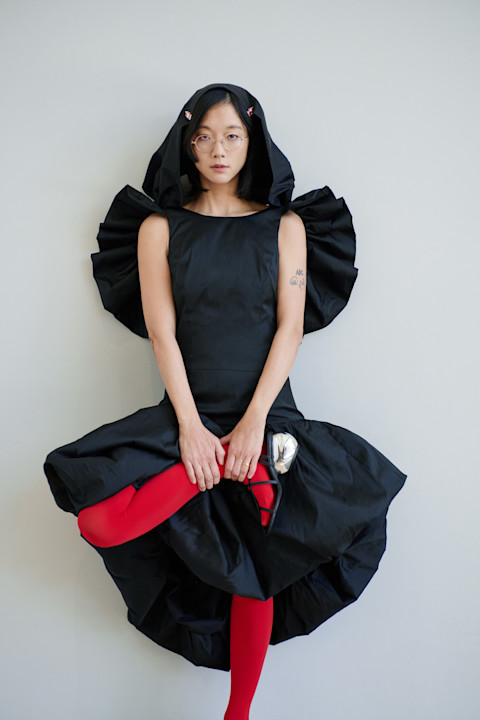
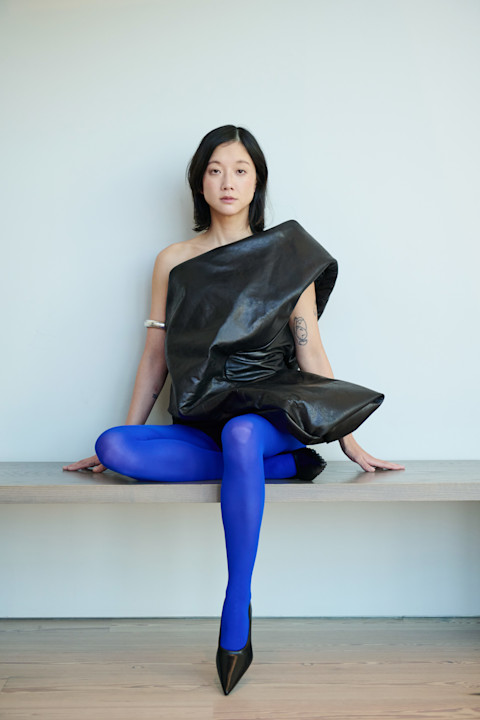
Over time her work has grown in scale: a billboard on the High Line in 2018 blew up one of her pieces “Too Much Future”;“Captioning the City” placed huge closed captions on various buildings (and a banner airplane) around Manchester. The third floor is devoted to another mural, “A Prolonged Echo,” which takes its undulating shape from the ASL word for echo. “Echoes are such a deaf experience, a deaf theme,” she says. “Everything that I get as far as information is concerned is typically repeated. Beth’s repeating what I’m saying to you. She’s repeating what you say to me. Captions are repeating what is being said. A lot of it’s indirect.” The following conversation, which has been condensed, takes place as we view the works in their various states of installation. The brackets indicate what we’re seeing—consider it a captioned experience.
***No, I enjoy this. And this is an earlier work, right? The p tree? []Are we moving chronologically?No you don’t.
Do you want to look around instead of me determining your journey? Because I feel like I don’t want to prescribe your experience.Yes. So this is the early nook. In ASL, because it’s a visual language, it doesn’t have its own written system. And so people have tried to come up with their own forms of writing systems for American Sign Language, whereas music, something that is intangible does have a writing system to it. I was getting into learning more about notation for music, thinking about what I knew about ASL, and I saw some similarities.Somewhat, but it’s also more thematic. Some of the themes are time-based, like early works, and some of the themes are categorized, like family. It’s been very challenging to plan this whole thing. To get 13 years of work in one place is really hard. And also to have to look back at my early work. Wait, I want to see your writing from 13 years ago.That’s how I feel right now. I’m just like, oh God, I made this so long ago. Do we really need to show it? But they say that’s important for a survey show. But it says “ears closed.” I wish I never said that. Can you imagine? These things that I don’t really engage in now and you won’t see in any of my more current work. []
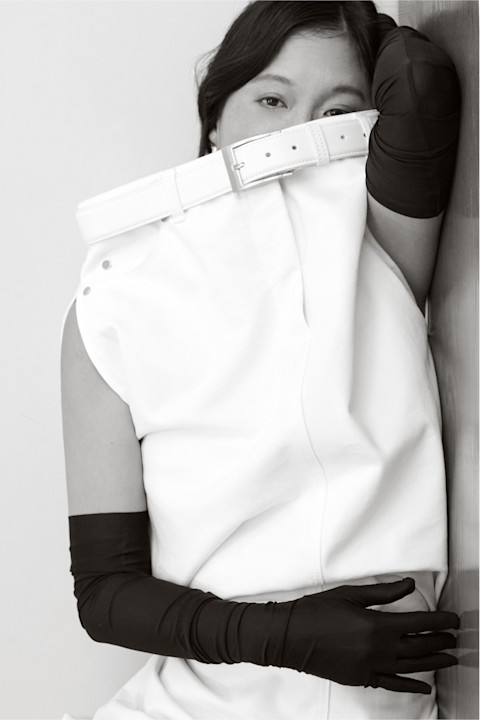
Are there ways in which you would want to recontextualize or push back against those earlier cringe moments?The seismic calligraphy? I really love these works. So I don’t think you should be embarrassed about early work. []
Basically I would just make everything less cringe. Let’s see: “All. Day.” So this is actually one of the few pieces that I used marker. You can see that it’s faded, which is what marker does. So I’ll show you the sign in American Sign Language. So here is the horizon line and here’s the sign. [] And as you know, this is how it moves. [] So this is one day, so you can show that it’s one day, but then this with the full palm is all day, all night. [] And so I followed the movements in these drawings. That’s what I was experimenting with back then. It also speaks to obsession as well. I’m just somebody who becomes really obsessed with things and then I give into that obsession. I guess I want to show this Todd Selby video from 2012. This is what basically opened the door into having a career for me. These are the pieces that I made in the video.I think it’s easier said than done, but I received your suggestion. What’s funny is people seem to really be into this. I think part of it’s because it communicates the idea of low frequency sound really well. When this video came out, there was a really strong response, but I was actually bored by it and I wasn’t sure what direction I wanted to take. I’m the kind of artist who doesn’t have a frame of reference. I didn’t grow up with a mentor in the field of art. I look up to other artists . . . ish, but no one’s really gone through my experience. And so it’s hard for me to figure out where to start. And that’s when I started going into some performance pieces.So this one I started with and then I realized I was still mad. [] So then I added another one, and then I was still mad. And then it wasn’t until I got to the sixth one that is about my personal rage. [“Degrees of Deaf Rage in Everyday Situations.”] And you can probably tell it has more charcoal than the rest. I was angry.
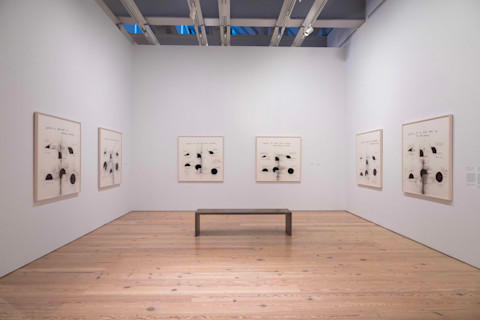
What’s a terp?A little bit, but I would be interested in hearing about your experience.Did you feel a sense of catharsis after completing these?The social relation is necessarily a part of the work.So how long have you two worked together?Who said that to you?Shit hearing people say to me? []Why’s that?
Interpreter. It’s shorthand. I also think that’s a military term for interpreters as well. I’m not sure if they still use it, but they did at one point. Interpreters is just a really long word. Are you familiar with the Bard MFA program?So it’s an art school upstate in the Hudson River Valley area. It’s a low residency program, so you go for three summers in a row. And for me, as somebody who didn’t necessarily have great hearing-people skills to figure out how to socialize, because I don’t lip read, I don’t use my voice. That experience forced me to learn how to interact with hearing people without looking like an idiot. Obviously there was a benefit to that, but there were a lot of moments where I realized people just didn’t want me there, which I understand. So I had some rage around it.I was sick for a whole week afterwards. Look, I’m not always angry, I just say it’s fine. I know we’re just meeting. I don’t want to be known as an angry artist. I just have rage. [] Thirteen years later. This canvas is the shape that the sign takes up in space to sign all day, all night. I did an exhibition around canvas. And part of the reason why I chose that is because I’ve had a lot of experience with different interpreters. Some are power hungry, some aren’t suited for my personality, some I’m too close to. And so it’s about how I have to work within the interpreter’s personality. If somebody is soft-spoken and that’s how they always talk, well then I’m going to sound soft-spoken.Yeah, it’s like dating.We started in 2014. Denise [Kahler-Braaten, who is walking along with us] is even longer—20 years. So I’m really lucky because I do have this core team of interpreters that I work with and everyone’s everywhere. Denise and Beth are two of my longer-standing interpreters. [] I performed at The Super Bowl right before COVID hit. This is the national anthem and this is “America the Beautiful.” This is more about how Beth and I worked together to have her cue me so that I would stay in hearing time with the translation that I had come up with for the songs in ASL, because every language has its own sense of timing. And so when the performers were singing, I had to make sure that my performance was in time with theirs. Like “O! Say, can you see . . .” How long are they holding “see” for? So Beth would cue me when they were done and I knew I could move on to the next line of my translation. She basically was my teleprompter telling me, “OK, this is when it ends. And then I knew to put my hands down because her hands went down.” And when they saw my performance, they were like, “Christine, I knew it. You could hear a little bit, can’t you?” And I was like, “No.” And they’re like, “Bullshit, you’re lying. I knew you could hear a little bit.”In jest. Some friends. But some hearing people were like, “Are you really deaf?”Well, this is why we put it here. These are split up into basically equal sizes because I get all of these things said to me equally. I’m currently most annoyed by this one. [] It’s like, you want me to talk to your baby like an adult? Hey baby, what book are you reading? I wanted this to kind of be the star of the show in this space. []About two or three years ago, I had a gallery show and there was a little tension around where to put this, because I wanted it front and center. And people were like, “Trauma, LOL”—not a great response to trauma. It was like, well, I have the comma. And that made people seem to receive it a little bit better. It’s a little bit like toxic positivity. And this is Deaf English, so to say, “Important. Cool,” means stay cool. Keep your cool. [] So this is the sign for debt. [] So it’s also a little bit like the gesture “pay up.” But this is like, you owe her, you owe me. So it has directionality along with possessions. And this came from a meme: How do you hold your cigarette? And how you hold your cigarette is which philosopher you are. So it was like, are you Descartes? Are you Socrates? I typically use known mass-consumed mediums like memes or sound and use those concepts to convey my work.I also think a lot about debt, because now I’ve been living in Berlin for about 12, 13 years. I thought I was just going to stay for two years. And next thing I know, I’ve got two kids, a German husband, a German family. Do you want to live in Germany?
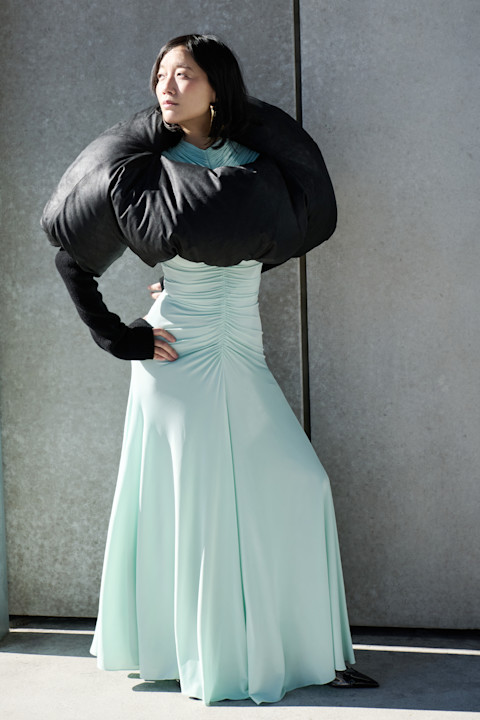
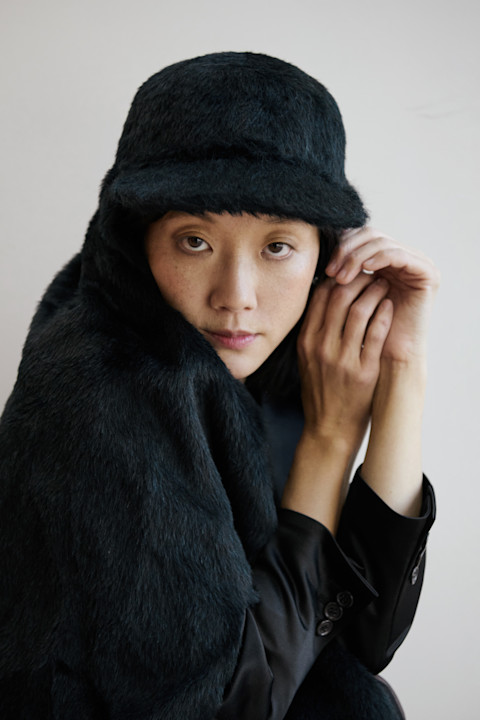
I don’t think so, but we’ll see how the political situation disintegrates here.I assume I’m missing something.Oh, that’s really fucked up.
Well, so I have friends in DC who are just freaking out because they’re losing their work, because of all the DEI stuff getting closed down. They’re losing their interpreters. They’re just getting fired or let go outright. And so I feel it looming, and I’m waiting to see how it affects me as well. But it’s fucking scary. So as I was saying, I was living in Germany and I was just seeing from a distance how much debt there is in the US. In Germany, I don’t pay anything for childcare for both kids. But here in the US it’s basically schooling. I was able to pay off my student loans only after moving to Germany and having a more reasonable cost of living. And so these are the things that I was thinking of basically how you hold your debt and then that brought me over here. [] So there will be three LED cubes that will be hung through the middle of the stairwell. I have an animation titled “A String of Echo Traps,” and this will play that animation and there’s a sound component. But what’s fun is that they get to be trapped on the cube and then people can experience that as they go up and down the stairwell. [] So you could look at this as a stack of chairs or a stack of tables. This concept of dinner table syndrome comes from the typical experience of hearing parents having deaf children. And there was research done around those family dynamics. Psychologists were going into families watching them have dinner and seeing what came out of that. In Korean culture, we love to sit around and have dinner; because two of us sign and our parents sign, we have access to what’s being said at the table, but not with my extended family. So I don’t get access to all the family lore, the family myths, the family stories. I don’t have a favorite uncle, because I can’t communicate with my uncles to have a favorite. And my family will be like, Christine, you act like we don’t love you, we do. And it’s like, no, I know that. But sitting at the dinner table with my extended family and doing it in silence and not being a part of the conversation is not fine. It was fine when I was a kid, but now that I’m an adult, it doesn’t feel as great. Just sitting there watching everyone laugh and have a nice meal together where they just sit there in silence. Do you know the fucking history around this guy? []So he is the inventor of the telephone, but he actually just stole the patent and filed it first. But that’s a different story. He’s at the top because he fucked us up for centuries. Well, like a century. He grew up with a deaf mom. He married a deaf woman and he was against deaf people marrying each other and using sign language.It totally is. In 1880, there was a conference in Milan on deaf education. All the deaf educators around the world came. At this point he has the fame and the wealth from inventing the phone. He’s besties with Helen Keller. So he’s got pull, he’s got the propaganda machine behind him. Now, before he attended that conference, there was a conference on deaf education because deaf education was doing really well. Deaf children were in school being taught in their country sign language by deaf teachers. And so deaf people were employed. Then Alexander Graham Bell came to the conference in 1880, spoke for three days to a hundred-something delegates. All of them were hearing, except for one deaf delegate. Alexander Graham Bell speaks for three days about how deaf teachers shouldn’t be employed. It should be hearing teachers, how deaf people should be assimilated into hearing culture. Don’t teach them sign, teach them speech. The eugenics movement was already in place at that time, but he was an avid eugenicist. He wrote on how to improve the human race. That’s why he was against marriage between deaf people, because he felt like that carried on bad genes and bad heritage. Because of him, the deaf community today is still struggling. We had oralism takeover, which is the practice of having deaf people use speech instead of sign language, which is not a full language to them. All the deaf teachers lost their jobs in 1880. Hearing people came into all the schools and banned sign language. It’s really sad. And that’s why I’m mad. The AGB foundation is still in practice today and they’re still so wealthy. So it’s like any organization that is pro hearing aids, cochlear implants, speech for deaf children, things like this. He wanted to permanently assimilate us as much as possible. And what I find really interesting is when you look at his paper on his text on deaf marriage, you can see that this is something he really believed. And my history lesson is over.[]So here it is. It’s not done. You can see the difference between there and here. So I can show you the sign for echo. So this hand is a surface and the action hand is sound moving to the surface and then bouncing off echo. And so what I did is reorient the sign to create the lines for the mural. And like I told you, I get obsessed with stuff and then I just iterate and iterate. So this is the echo waves basically. And I’m trying to create an echo trap in this space. There’s no way out. It’s everywhere. It speaks to how the system isn’t designed for us. And so the ideas that are in place—audism, ableism, racism—are fixed, are hard to change, aren’t flexible, repeat themselves and create the echo trap that we have to live in. And sometimes echoes are really strong and sometimes it’s like a shitty thin echo.[]
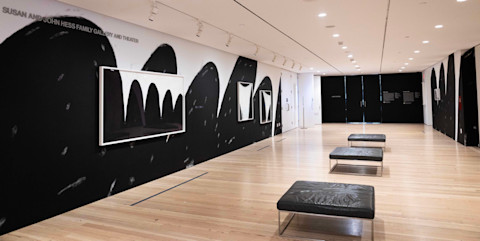
In terms of obsessions, I’m curious what your current obsessions are?My understanding is that you used to work at The Whitney back in the day.There’s a space-time aspect of ASL, three-dimensional Euclidean space plus time, and a lot of the works are two-dimensional charcoal drawings on paper. How do you come upon the right medium or dimension to suit an idea?Do you feel like you’ve been able to successfully challenge or change how an art institution works with you?
So I’m dealing with guest-list frustrations. I know it’s so stupid. Like for all the different events that I get to do while I’m here. And so there’s a gallery dinner, there’s a board of trustees dinners, and I always feel like I’m the first to break into certain spaces from the deaf community. And because of that, if I want to invite one deaf person, I have to invite all the deaf people. With the catalog for the show, I have a list of acknowledgements and I became really obsessed with who I was going to name. I was obsessing for six months. I was losing sleep over it. I was like, what if I forget somebody? I’d wake up in the middle of the night. I’ve lost friends because I haven’t invited them to certain events just because of how the community can be. Then Tom Finkelpearl [a co-curator of the show] said it’s always better to thank more people than less, obviously. He’s had moments where looking back, he wished he had thanked more people when doing those books that he’s published. So then I had this huge list, and I’m sure I forgot a few people despite all my efforts. But then I’m dealing with all the guest list plus-one drama for the events. And admittedly, this is what’s been taking up the past two months of my life. I feel like I’m planning a wedding if anything.I went to SVA School for Visual Arts here in New York. I think I was a little naive: I thought I would start working full-time as an artist right after that. So I worked at W.W. Norton. I was a digital archivist and then I also was working at The Whitney, but I actually had an internship at The Met. So this is what I was doing and I felt like I was in the space. I got the job offer to come here to educate at The Whitney. And at the time they were doing monthly tours with interpreters. So I thought about how I love art, but I also felt like an art failure. I wasn’t succeeding as an artist, but I learned how to give tours. I was able to get access to material that essentially felt like a crash course in contemporary art history. When I felt like my art career got to a point where I was a full-time artist, I left and moved to Berlin. It’s nice because they still have the monthly tours given from deaf people to deaf people in sign language. And now I’m back as an artist. It’s really special.Honestly, I’m not sure. I’ve also made a lot of bad work that I’ll never put online. Oftentimes I have the core idea in place and then I test out different mediums and formats. Is this something that translates better into text or something else? Admittedly, most of my ideas get conveyed better in text. It’s this middle ground of meeting people in a way that doesn’t ask too much of the other. We don’t know each other’s languages. But text is something we both have access to.Yes and no. I need accommodations which aren’t cheap, and so that kind of forces them to meet me. I also love to bring my family. That’s also not cheap. So here at The Whitney for example, they gave me an apartment and I made sure I got a crib and car seats. So it’s like if I challenge too much, it hurts my access. And so that’s why I have to smile and make nice. But I always feel like I do wish that I didn’t have to be as collaborative. Sometimes I have to collaborate in my everyday life, whether that’s with the interpreters, with the hearing people that I engage with. I’m very, very talented at collaboration. But I wish I didn’t have to be. I wish I could just be like, I want this, I want that, and I get it. Give me three cups of coffee now. I know people who are like that and they get away with that and I just can’t, if it’s like, oh, she’s a bitch. I’m not going to give her her interpreter request, then I don’t get my interpreters. So it feels like I have to keep playing that game that’s in the system. I’m looking forward to getting to the point where I can just ask for whatever I want. I’m not there, but I feel like I’m on my way.
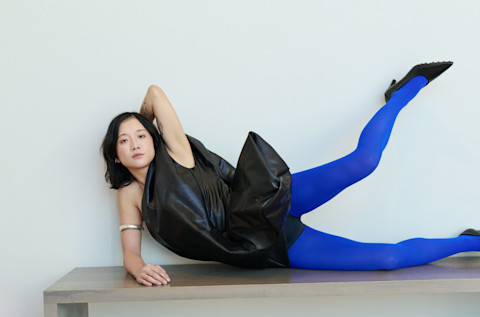
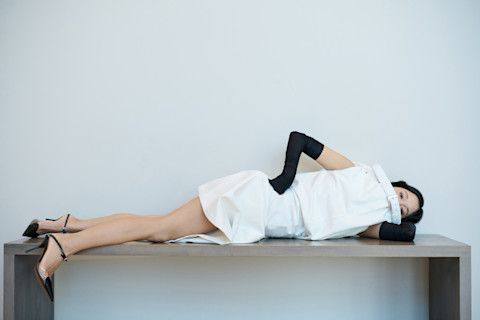
How would you like to see things fundamentally shift?How are you generally refilling the well of inspiration? Where do you go to renew that? How do you find a new obsession?Is there a specific trauma point that you’re focusing on to work out? I know EMDR usually works with a very specific memory.Do you think about Koreanness in your practice?That’s interesting because a lot of the charcoal drawings read Korean to me in a graphic sense. It reminds me of the stuff I would see in Hongdae in Seoul.
Have staff interpreters, simple things that make things more accessible. Or can you caption all of your fucking videos? Not just some. I love burnt-in captions, but not everyone does. They’re like, oh, it ruins it. And it’s like really? Just put ’em on. But the things I would challenge are simple things where I want a world where I can just show up at a museum lecture last-minute, and I don’t have to book in advance to be like, oh, there’s a talk in an hour. I can go. Because if I want to go, I have to find it out in advance. I have to reach out to the accessibility manager, usually give them about two weeks notice. And if an interpreter is available that they can find and that they can afford, then it gets worked out. But I just want to go to stuff. I want to go to Broadway whenever I want. I’d love to see things be accessible without asking or without being told that there’s no budget or there’s no availability. To me, having better access to things creates a better quality of life, and that’s something I want for everyone.Honestly, they just fall in my lap. Something drives me crazy, and then I become obsessed with it. Sometimes my husband is like, Christine, you’re still obsessed with this thing that happened years ago. And I’m like, yeah, of course. I have ADHD. I also love EMDR [Eye Movement Desensitization and Reprocessing] therapy. So I’ve started to do that. To calm down a little bit.Do you remember how I mentioned that I stopped talking to some of my cousins when we were talking about dinner table syndrome? That’s actually one of my target events. And so working through that to process it and to let go and to move on. But admittedly, moving on isn’t quite my thing.I do. I struggle. I think because I’m so obsessed with deafness at the moment, and I’ve always been obsessed with how to be a better deaf person or how to be as deaf as possible, just because of stuff that I’ve experienced growing up. But I just did an interview with a half Korean writer and they said that my work appears very Korean in the wittiness, in the talking back attitude a little bit. So they said my work is actually quite Korean, but I don’t know.This actually makes me think. So whenever you see my handwriting and stuff, when I do all caps, I think that kind of comes from my ex who thought my idea of working with sound was crazy because his dad is a big-time Hollywood producer and always wrote in caps. And I was like, I want to be powerful like that. So I was like, I’m going to write in all caps. I don’t know if he knows that.
New York Magazine.
 Introducing Spring/Summer 2025 The Spring/Summer 2025 collection begins with the essence of sport: power and grace, precision and freedom. Athletic elements are twisted and reinterpreted. Swimsuits are densely embroidered with sequins; belts and ties mirror the gesture of martial arts jackets; color-blocked sweaters evoke jerseys. Spring handbags include the trio of shapes in the new Romy collection, an oval Pierced shoulder bag and the soft, slouchy Balloon. Nearly every shoe draws on the construction of a classic ballet slipper, like the Peep-Toe pump and newly reinvented Reva ballet – marking the return of a brand icon.
Introducing Spring/Summer 2025 The Spring/Summer 2025 collection begins with the essence of sport: power and grace, precision and freedom. Athletic elements are twisted and reinterpreted. Swimsuits are densely embroidered with sequins; belts and ties mirror the gesture of martial arts jackets; color-blocked sweaters evoke jerseys. Spring handbags include the trio of shapes in the new Romy collection, an oval Pierced shoulder bag and the soft, slouchy Balloon. Nearly every shoe draws on the construction of a classic ballet slipper, like the Peep-Toe pump and newly reinvented Reva ballet – marking the return of a brand icon. 

